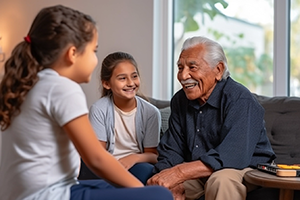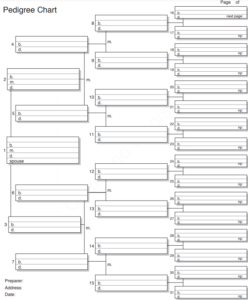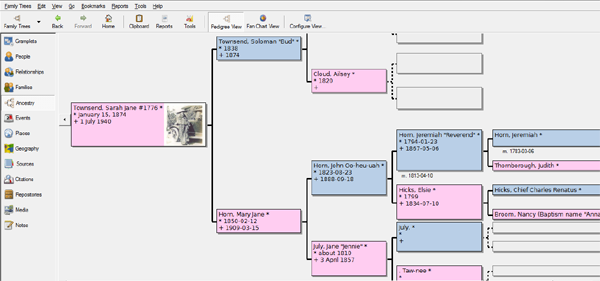Embarking on a journey to discover your Cherokee heritage you’ll encounter both the tangible and the elusive. It is a delicate blend of history, family lore, and hidden connections. Our guide aims to demystify this process, starting with a crucial step: creating a lineage chart.
Begin by tracing your roots from the present day back to a pivotal moment—the year 1950. Why 1950? It’s the most recent year for which census records are accessible, providing a snapshot of our ancestors’ lives. However, beyond 1950 (more recent) lies a veil of privacy restrictions, making the quest for information a complex challenge.
In this guide, we’ll explore how to construct your lineage chart, gather details, and navigate the twists and turns of Cherokee genealogy. While doing so, let’s honor those who came before us and weave their stories into our own, because you also have a story to tell.
STEP #1: IDENTIFY YOUR ANCESTORS

Talk to Family: Start by chatting with older family members who should share the same Cherokee lineage. Gather basic info like names, birthplaces, and locations where your Cherokee connected ancestors lived. This may also include Freedmen, Delaware, or Shawnee. Remember, nobody has only one Cherokee ancestor.
Record Details: If possible (with permission), record audio or video to transcribe later. Get names, birthdates, marriage dates, and any other important information about your parents, grandparents, and great grandparents. See how much of a pedigree chart you can fill in, then ask who may know the rest. We have free printable forms for collecting this information, as well as a link to free GRAMPS genealogy software on this page.
 |  |
Use Resources: Look for old family bibles, photos, postcards, and documents that might contain family tree details.
Once you have information back to 1950 you can begin to use census information from online resources.
STEP #2: SEARCH HISTORICAL RECORDS
Check Specific Rolls: Once you have birthdates and locations you can verify that a similar name on a roll is actually your ancestor.
Use your lineage chart (pedigree) to search for ancestors on specific rolls (See our Cherokee rolls page) like the Dawes roll, Baker roll, or Guion-Miller roll. This is the largest and has much information.
If you have African-American ancestry, explore the Dawes Freedmen rolls, Wallace, and Kern-Clifton Rolls.
STEP #3: APPLY FOR TRIBAL CITIZENSHIP
Gather Documents: Collect necessary documents like birth and death certificates of your ancestors.
Complete Application: Fill out tribal citizenship applications using the gathered family tree information.
Don’t Give Up: If you can’t find an ancestor on the rolls, keep searching. Names might be misspelled or records might be incomplete. Some Cherokee married into other tribes and are on their rolls.
Remember, each step involves careful research and documentation. Don’t hesitate to seek help or further information to uncover your family history.
TRIBAL ELIGIBILITY:
According to the U.S. government, individuals of Cherokee ancestry fall into one of four categories.
The first three are federally recognized tribes:
- Eastern Band of the Cherokee Indians of North Carolina
- United Keetoowah Band of Cherokee Indian of Oklahoma
- The Cherokee Nation of Oklahoma
- “All other persons of Cherokee Indian ancestry”
The Eastern Band requires that a person have a direct lineal ancestor must appear on the 1924 Baker Roll of the Eastern Band of Cherokee Indians and possess at least 1/16 Eastern Cherokee blood. This blood quantum is calculated from your ancestor on the 1924 Baker Roll. It’s also required to take a certified DNA test establishing the paternity and/or maternity of the applicant from a lab acceptable to the tribal Enrollment Committee. This is the only DNA test acceptable to any Cherokee tribe and is only used for paternity/maternity testing.
To be eligible for United Keetoowah Band membership, Cherokees must be able to provide documentation that they are a descendant of an individual listed on the 1949 United Keetoowah Band Base Roll or of an individual listed on the final Dawes Roll. Applicants must be one-fourth Keetoowah Cherokee blood quantum, which is calculated through the blood quantum listed for your ancestor on the aforementioned rolls.
The Cherokee Nation of Oklahoma (now simply called Cherokee Nation) requires proof from the applicant of a direct biological ancestor listed on the Final Rolls of Citizens and Freedmen of the Five Civilized Tribes, taken between 1899 and 1906 in Indian Territory, now Oklahoma. It requires NO particular degree of Indian blood.
